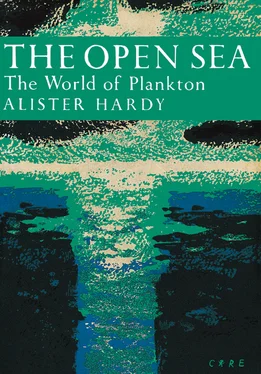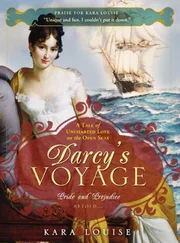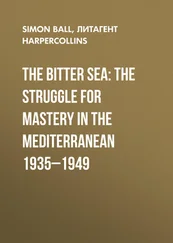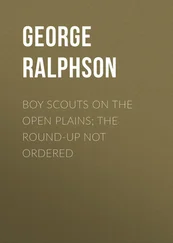1 ...8 9 10 12 13 14 ...25 FIG. 9
Map showing the distribution of three kinds of water round Great Britain each characterised by a different species of the arrow-worm Sagitta: serratodentata in open ocean water, setosa in coastal water and elegans in oceanic water mixing with the coastal water. The conditions are those which might be expected in the autumn of a year with a strong Atlantic influx into the North Sea from the north. From Russell (1939), but modified in the north in the light of more recent surveys and with some other details omitted.
Mr. F. S. Russell, the present Director of the Plymouth Laboratory, who carried out these studies on Sagitta (1935, 1936) and young fish (1940), made cruises to trace the boundaries between the different kinds of plankton. He has told me how very abruptly one type of water may give place to another. On one occasion he has said it was even possible to place the ship across the very margin between them, so that elegans water could be sampled from the bows and setosa water from the stern! Fig. 9, shows the general distribution of the elegans and setosa water round the British Isles as it might be expected in the autumn of a year in which there is a strong influx of Atlantic water into the North Sea from the north; it is taken from another of Mr. Russell’s papers (1939). These different waters may also be sometimes discernible by a difference in their colour, a contrast of shades of blue and green making a line across the sea. In 1923, when on the staff of the Fisheries Laboratory at Lowestoft, I acted as observer in some attempts to locate shoals of herring and mackerel from the air. In flying from Plymouth to the western mackerel grounds we passed over a sharp line separating the green water of the Channel from the deep blue of the Atlantic; it ran on a slightly irregular course from the Lizard to the south-west as far as we could see to the distant horizon. Then while circling over the mackerel area we saw another equally definite boundary running from Land’s End towards the Scilly Isles separating the deep blue water from a more brown-green area lying to the north. At that time I could not interpret that striking pattern of colour contrasts; now on looking at Mr. Russell’s maps I have little doubt that the blue area I saw was oceanic elegans water lying between the setosa water of the English Channel and that of the Irish Sea. Fig. 10shows a comparison between my sketch of these colour boundaries, which was published in the official report (Hardy, 1924a) and Mr. Russell’s maps of the distribution of the setosa and elegans water in the same area but in different years (Russell, 1935, 1936). If these marked colour-changes can be correctly interpreted we may in the future find aircraft being used to make rapid surveys of the surface conditions in relation to the fisheries. The actual experiments in spotting shoals offish were not successful in these waters; in the southern North Sea the water was too opaque with the large amount of sediment constantly stirred up by tidal currents running over sand and mud banks; at the western entrance to the Channel the ocean surface was too much broken up by waves into light and shade to allow of any observations below it.
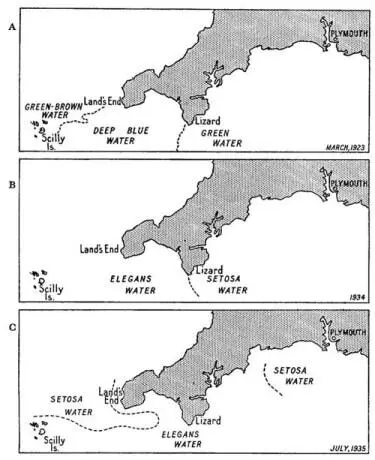
FIG. 10
Well defined areas of blue and green water (A) seen from the air during mackerel spotting tests off Cornwall in 1923 drawn from the chart by Hardy (1924) and compared (B and G) with the distribution of western and Channel water as indicated by the arrow-worms Sagitta, elegans and setosa , charted by Russell (1935 and 1936).
In the shallower waters—especially in the southern North Sea—we must not forget the influence of the tidal streams just mentioned; they may have a most profound effect in modifying the action of the main currents, especially when they vary so enormously in their force between spring and neap tides. At spring tides in certain places a mass of water may be moved for some thirty or forty miles in each direction.
The movements of water in the Irish Sea are also dominated by tidal currents; these flow into it from both ends and follow the general direction of the coast lines. Professor K. F. Bowden, who has given us such an excellent account of these tidal streams (1953), writes, “Knowledge of the non-tidal drift, however, is much less certain and is based on indirect evidence. It was recognised at an early date that the distribution of salinity indicated a north-going drift and in 1907 Knudsen estimated that the rate of flow was such that the water in the Irish Sea would be completely renewed in a year.” After saying that “this implies a flow through the Dublin-Holyhead channel at an average rate of just over a kilometre a day,” he later stresses that, although there seems little doubt about this average northward movement, “its magnitude, its variations and the degree of its dependence on the wind are still uncertain.”
We have now dealt with the main water movements round our islands; later in the book we shall see instances of more local effects and how upwellings and the mixing of waters may be important in producing a richer plankton. I will end the chapter by referring to some surprising and significant plankton records being made by Dr. J. H. Fraser (1952e, 1955) of the Scottish Fishery Laboratory at Aberdeen. In some years, over a wide area to the north of Scotland, he finds plankton animals which we should more usually associate with the latitudes of the Mediterranean; they indeed indicate a very unexpected movement of water. It now appears that some of them may in fact actually have come from the Mediterranean Sea itself.
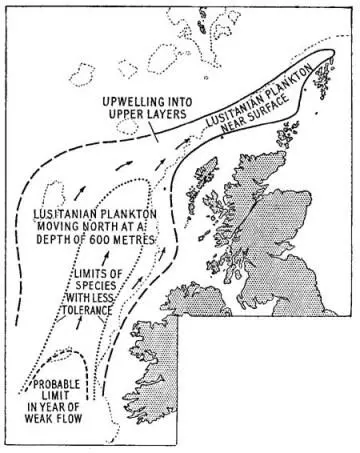
FIG. 11.
A chart showing the northward flow of the ‘Lusitanian’ plankton; kindly provided by its discoverer Dr. J. H. Fraser of the Scottish Fishery Laboratory, Aberdeen.
It has long been known that a surface stream of Atlantic water flows eastwards through the Straits of Gibraltar and that this influx is balanced by an outpouring (at a lower level) of Mediterranean water of very high salinity; this spreads out from the Gulf of Gibraltar underneath the North Atlantic water and some of it is carried north up the edge of the European continental shelf. This movement is well summarised in Sverdrup, Johnson and Fleming’s important book The Oceans (1942, pp. 646, 685–6) which, for the serious student, gives such an excellent account of the main results of modern oceanography. Dr. L. H. N. Cooper of the Plymouth Laboratory has recently (1952) made a study of the distribution of this water to the west of the British Isles as it continues northward below the Atlantic water at a depth of some 600 to 1,200 metres. How far north it goes seems to vary greatly in different years; in some it appears to go no further than the west of Ireland, but in other years it flows onwards to upwell and spread over the continental shelf. Its course has been followed by Dr. Fraser by finding its typical but exotic fauna in his plankton nets; to the west he finds it deep down—but let me quote from his recent paper.
“It apparently follows the edge of the Hebridean Continental shelf, mixing on its western edge with open oceanic water, and upwells somewhat on the east side to overflow and mix with coastal water on the shelf. In some years this current may not reach Scotland or is too weak to be recognised, but on occasions it is sufficiently strong to continue into the South side of the Faroe Channel, though it only rarely penetrates beyond the north of Shetland. Frequently, however, it mixes with the coastal water on the shelf and the resulting mixture floods the area to the west of Orkney and often passes through the Fair Isle-Orkney Passage into the Moray Firth area.”
Читать дальше
